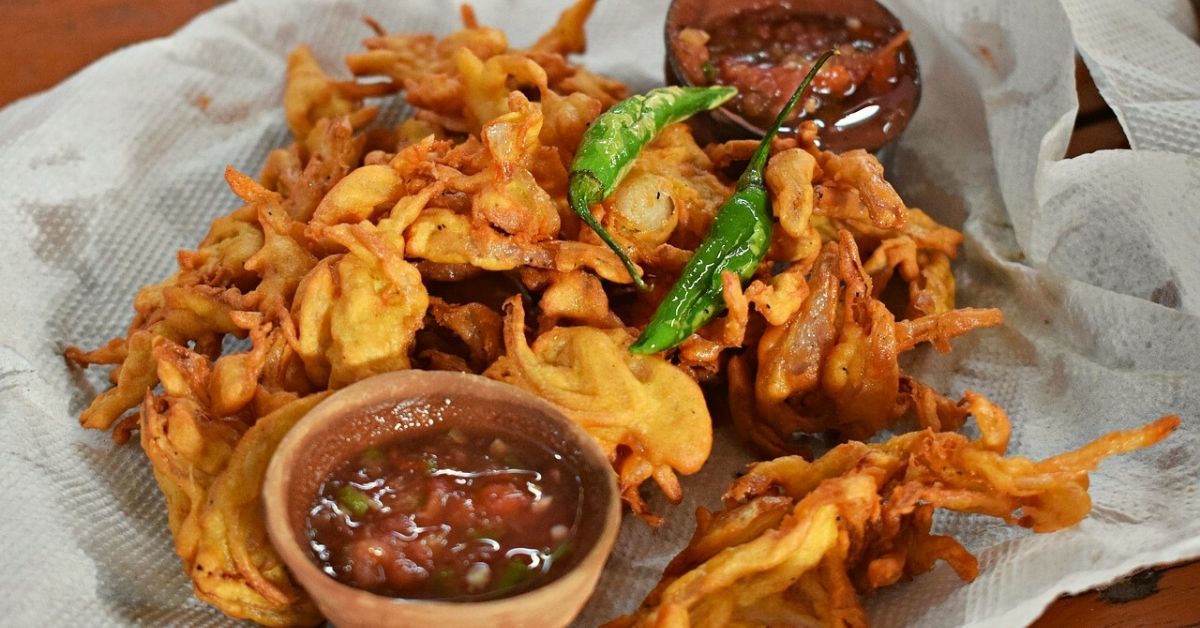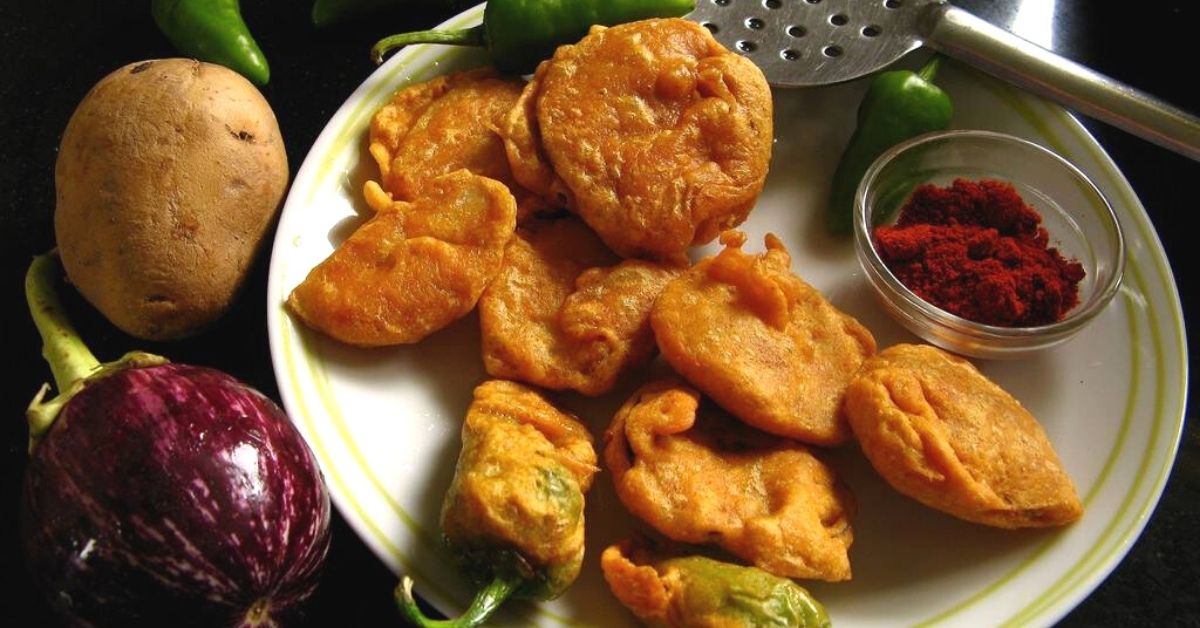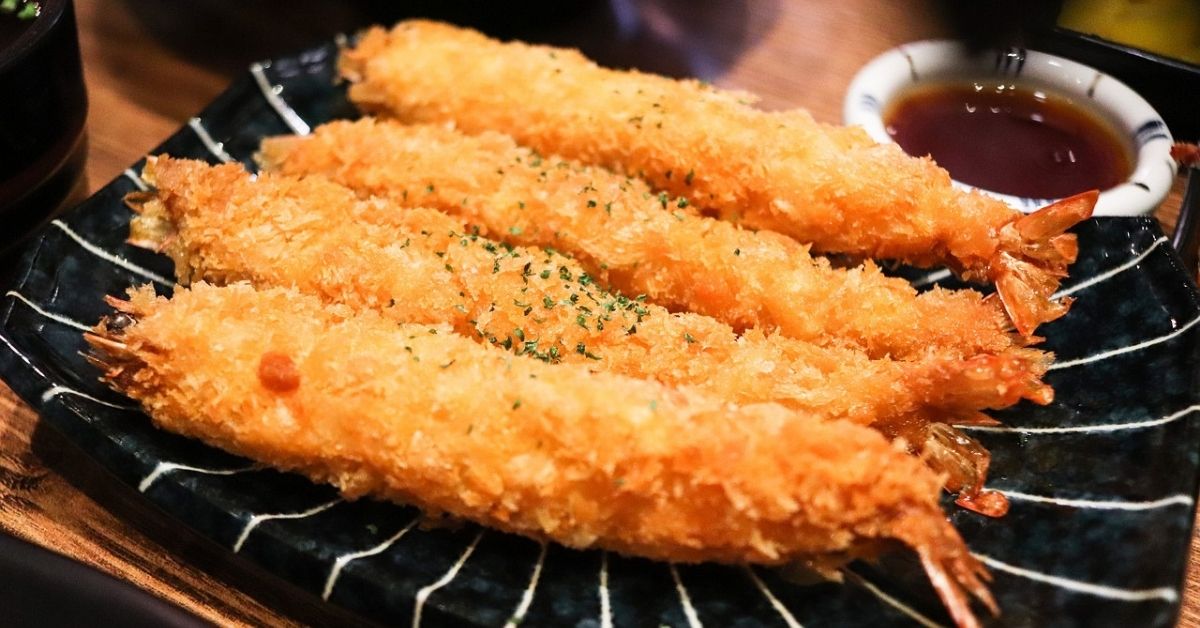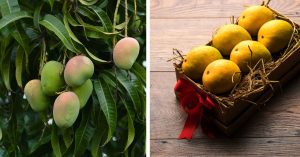Pakora Map of India: The Delicious Story of India’s Deep-Fried Wonders
Indian pakoras go by many names across different states — tele bhajas, begunis or vengayam pakoras, but they are an emotion wrapped in layers of spiced besan and fried till golden brown.

As the sky growls angrily announcing the impending showers, my mother rushes to the kitchen to make arrangements for the grand arrival. In a matter of minutes, a thick batter full of wondrous flavours is ready. She scoops out delicate balls of the batter and releases them into the hot oil. Then, a magical duet ensues as the sizzles of the oil welcoming the tiny balls, join the cheerful pitter-patter of the raindrops hitting the window. Served with a piping hot cup of tea or coffee, ‘tele-bhaja’ as they are called in Bengali, manage to bring joy with every bite.
Although a personal memory, I cannot lay claim to it as this is a nostalgic moment experienced by almost every Indian. Adored across the country, this comfort snack has a number of names like tele-bhaja, bhajji, bonda, vada, etc. But, in a more generic sense, we all know it as the humble but absolutely fabulous pakoras.
A snack that is easily found in almost every corner of the country, pakoras are a simple dish packed with complex flavours. In a moment it can metamorphosize from being the star of a tea-time ritual to a reliable side-dish in a meal. For instance, in some Bengali families, tele-bhajas form an integral part of the multi-course daily meal.
Almost any vegetable, greens, fruits, fish or even meat can be made into pakoras, which reminds me of a funny story about my neighbour who would refuse to have her meal without a bowl of tele-bhajas on the side. One day, to teach her a lesson, her mother picked up some fresh grass, washed it thoroughly and dipped in a thick spiced batter of besan (chickpea flour) and fried it for her daughter, who unbeknownst enjoyed the same for lunch.
Whatever be the memory, this dish is an emotion wrapped in layers of spiced besan or any other kind of flour, and fried till golden.
United in ‘Pakoras’

Be it begunis (eggplant pakora) served in Durga Puja bhogs, Mumbai’s batata vada (potato pakoras) or the stringy onion crisps called vengayam pakoda served in Chennai, almost every region in India boasts its unique variety of pakoras. Although the West has its fritters and beignets, the chickpea flour batter and the concept of ‘pakki rasoi’ and ‘kachchi rasoi’ are exclusive to Indian pakoras.
Indian cuisine was broadly divided into two sections—pakki rasoi and kachchi rasoi—based on the process of preparation of food. While ‘kachchi rasoi’ entailed boiled or raw foods that couldn’t be stored for long, ‘pakki rasoi’ included foods that were fried and stored for longer, especially during long travels. The high heat used to fry the food ensured little to no moisture was left in it.
With time, the round pakwata (‘pakka’ meaning cooked and ‘watta’ meaning laddu) began to be colloquially known as ‘pakoras’.
Inspiration Behind Japanese Tempura

This unique dish, in all its diversity, also traveled across the globe, influencing and assimilating into foreign palates. One such prominent influence of Indian pakoras can be found in a Japanese a delicacy — the tempura.
According to food experts, back in the 16th century, Spanish and Portuguese ships would stop in India while enroute to Japan. During the halt, they would onboard cooks from India who were said to have taught the Europeans different ways to consume vegetables, with pakoras being one of the dishes served. Eventually, when the ships would reach Japan, many of the Indian cooks would stay back who went on to influence Japanese cuisine and helped create the dish called ‘tempura’.
There was no tempura in Japan before the Portuguese traders. What solidifies this theory is the fact that tempura continues to be an anomaly in Japanese cuisine where deep-frying is not traditionally practiced. Most of their fried dishes are shallow-fried instead.
However, unlike our pakoras, the sophisticated tempura version uses wheat flour which makes them more crispy.
Over the years, pakoras have undergone myriad changes. A traditionally vegetarian dish, it has come to embrace several complex Indian flavours and textures, and sometimes even experience fusion twists. Yet through all of these transformations, it has never failed to lose its brilliance and the ability to provide comfort in every single bite.
Check out the Pakora Map of India
Kushi Keraw Dal pakora (small green peas pakora)
Ingredients
Keraw (250 g)
Turmeric- 1 teaspoon
Salt to taste
Green chillies – 2
Red chilli powder – 1 teaspoon
Ground pepper – ½ teaspoon
Besan – 1 cup
Garlic – 2 cloves finely chopped
Small ginger – finely chopped
Coriander seeds – 1-2 tablespoon
Cumin seeds – 1 tablespoon
Onion – 1 finely chopped
Coriander leaves
Vegetable oil
Method:
Soak the keraw dal overnight and drain.
Blend the keraw dal into a coarse paste, while keeping 2- 3 tablespoons of dal aside in its whole form.
Incorporate all the ingredients in a bowl to make a thick batter. Make small flat balls and deep fry in vegetable oil until golden brown.
Serve with coriander and mint chutney.
Credit: Seema Kumar, a home cook from Bihar
Neerphanas Bhajji (jackfruit pakora)
Ingredients
Half a neerphanas (breadfruit; about a kg) or jackfruit
Red chilli powder – 1 teaspoon
Besan – 1 cup
Rice flour – 1 cup
Carom seeds – 2 teaspoons
Cumin powder – 1 teaspoon
Hot chilli powder – 1 teaspoon
Salt to taste
Green chilli paste – 1 tablespoon
Garlic paste – 1 tablespoon
Ginger paste – 1 tablespoon
Dry mango powder – 1 teaspoon
Water – ¾ cup
Vegetable oil
Method
Peel the breadfruit or jackfruit and cut lengthwise into two parts and make 6-8 mm thick slices. Make sure to remove the seeds.
Lightly apply salt and chilli powder and allow it to rest for 30 minutes.
Mix all the other ingredients in a bowl to make a batter.
Dip the slices in the batter and deep fry in medium hot oil until golden brown.
Serve hot with chutney.
Credit: Sangeeta Khanna
Prawn head and legs pakoras
Ingredients
Heads and legs of King prawns or giant river prawns (250 g)
Cleaned and deveined prawns (optional)
Onion – 1 chopped
Green chillies – 2 chopped
Garlic cloves – 4 cloves finely chopped
Ginger – finely chopped
Coriander
Turmeric – ½ teaspoon
Salt to taste
Chickpea flour or Besan – 1/2 cup
Garam masala – 1 teaspoon
Red chilly powder – ½ teaspoon
Mustard oil (to saute) – 1 ½ tablespoon
Vegetable oil (for deep frying)
Method
Thoroughly clean and devein the prawns and use the legs and heads, which are usually thrown away, to make this pakora.

Similar Story

Order Organic Mangoes From Farms Across India Using 8 Online Platforms
The season of ‘aamras puri’ is here! If you haven’t stocked up on mangoes yet, here are eight platforms that deliver organic mangoes from farms across India to your home.
Read more >
Make sure to remove the eyes and antennas of the prawn before proceeding.
Once clean, let the excess water drain and saute the prawn parts along with the prawns (optional) in mustard oil, till they turn orange.
Strain and keep aside to cool. Make a coarse paste with some oil and water.
Add all the ingredients in a bowl and mix till you can form balls out of it.
If you found our stories insightful, informative, or even just enjoyable, we invite you to consider making a voluntary payment to support the work we do at The Better India. Your contribution helps us continue producing quality content that educates, inspires, and drives positive change.
Choose one of the payment options below for your contribution-
By paying for the stories you value, you directly contribute to sustaining our efforts focused on making a difference in the world. Together, let’s ensure that impactful stories continue to be told and shared, enriching lives and communities alike.
Thank you for your support. Here are some frequently asked questions you might find helpful to know why you are contributing?


Deep fry in vegetable oil and serve with some coriander chutney or kasundi.
Credit: Indrani Barua, a home cook from West Bengal.Edited by Yoshita Rao
This story made me
- 97
- 121
- 89
- 167










